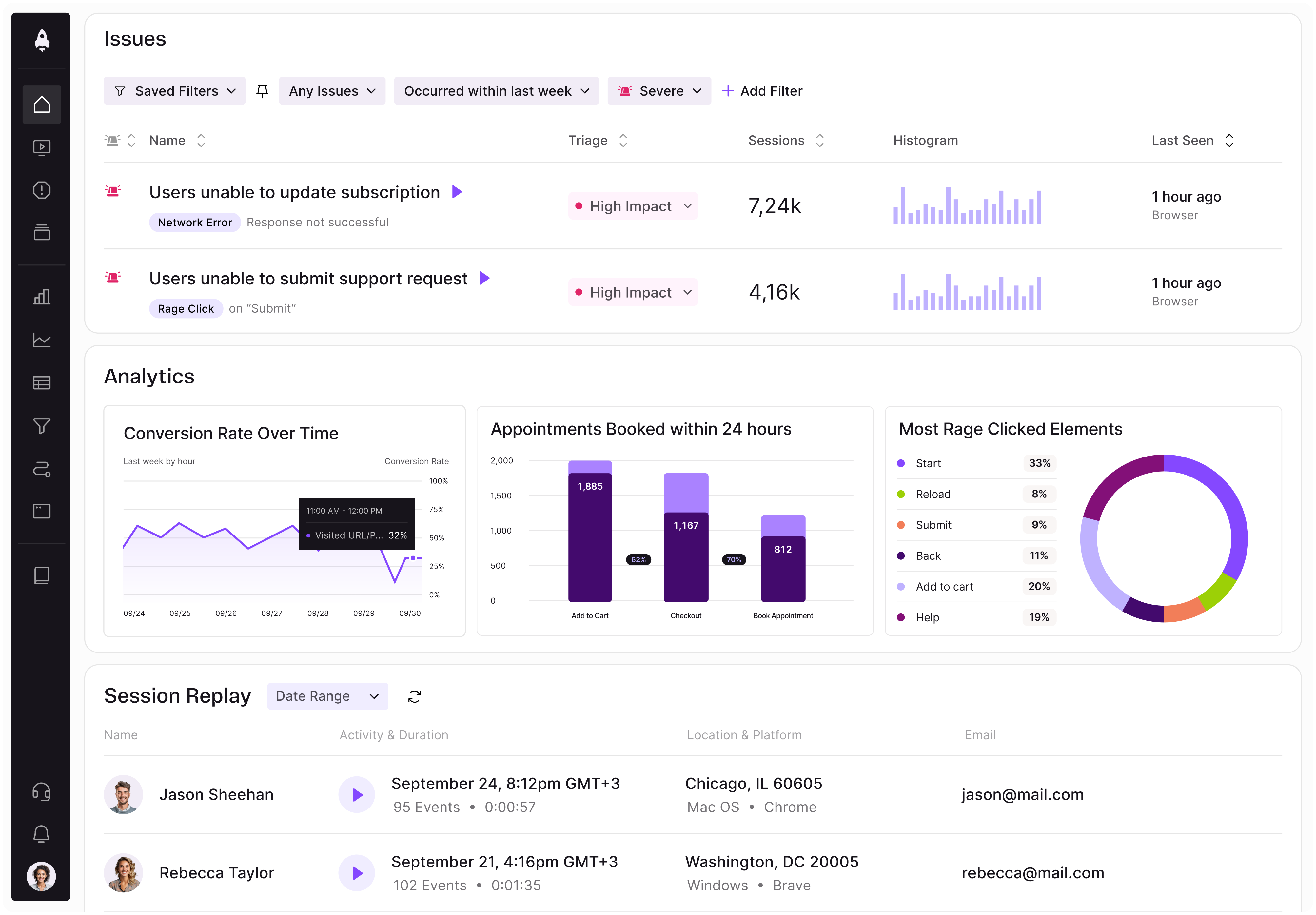Not long ago, I spent countless hours manually analyzing customer feedback trying to spot patterns or performing research to conduct competitive analysis. If you’re a product manager, you’ve probably been there too. However, AI has transformed how you can approach market research.

In my work with product teams, the key isn’t just using AI. You also need to know how to combine it with human insight. Think of AI as your research assistant: incredibly fast at processing information but needing your strategic guidance to deliver real value.
Keep reading to learn the steps to integrate AI into your market research, popular tools for AI research, and key applications.
When considering market research with AI, try employing the following process:
The first, and most crucial step in the research process is planning. You want to have a clearly defined goal and outcomes from the start. Take the time to answer questions with your team and avoid using AI here.
Example questions include:
Depending on your goals and constraints, you need to decide on which research methods to use. While there are a lot of options, the most common ones are user interviews or surveys, especially in the discovery phase, as well as secondary research — document analysis, and online research. Hold off on using AI in this step as well.
From here on out, leverage AI to help you prepare, perform, and analyze your results. This is the stage where you create your interview guide, survey questions, observation sheet, or criteria for evaluating your competitors.
Now, you need to perform the research and record the data.
The last step is the most important one, as it’s the moment you analyze the data, find patterns and derive insights in.
For your reference, save and review the following image below:

Through trial and error, I’ve found that AI tools like ChatGPT, Claude, and Perplexity can be game-changers, but only if you use them strategically and know their limitations.
Since AI is non-deterministic by nature, you need to treat with a critical eye whatever results it provides. For best results, do thorough planning beforehand and test the results of the AI instead of trusting them blindly.
Now that you have a sense of how to use AI, this section outlines three key applications for market research.
When it comes to research design, the most common use case for AI is helping structure user interviews or user survey questions, and also refine them. Given enough context, this approach will save you some time. However the real power of AI in research design isn’t just generating questions – it’s helping you think through scenarios you might have missed.
Remember to always cross-reference AI findings with raw data samples, and make sure you give your AI enough context about your product, market, etc.
Start off by asking the AI to give you the overall structure of the interview guide. To make sure it has all the details, I always include a note in the prompt asking the AI to ask me any questions so that it has all relevant information to deliver the best result.
“Act as an experienced user researcher – Create an interview guide for [specific user persona] focusing on their experience with [specific product/feature]. Include questions about their goals, pain points, and current workarounds. Ask me any questions to get all the information you need in order to provide me with the best result.”
“Act as an experienced user researcher – What are potential blind spots in researching [specific topic] with [target audience]? Consider cultural, technical, and practical factors. Ask me any questions to get all the information you need in order to provide me with the best result.”
“Act as an experienced user researcher – Review these interview questions [paste questions] for potential bias or leading language. Suggest improvements.”
“Transform these technical questions [paste questions] into user-friendly language for [target audience].”
Unless given specific context, keep in mind that the AI tends to generate very generic questions or miss industry-specific nuances.
Some questions can be leading or biased, so never take the list of questions as is. Always refine and double-check it. It also helps to apply the four-eye principle and ask a peer to review your research instrument before proceeding to the next step.
To help avoid common pitfalls:
Picture this scenario: You need to make sense of customer reviews, support tickets, and survey responses. Your stakeholders needed insights yesterday, and manually analyzing all this data would take weeks. Sound familiar?
Here’s my approach: Get the AI to categorize your feedback, then perform human validation.
First and foremost, make sure you anonymize all the data and remove any sensitive information. Also, if that is the case, check with your DPO and AI policies. Then, feed the raw data for the initial categorization. You want to look for sentiment patterns and recurring themes. Also ask the AI to flag potential urgent issues.
If you’re doing this for the first time, I recommend you only feed it a sample of the data to make the second part easier.
Once you get the results, take a critical look at at least 10 percent of the categorized feedback while paying special attention to the outliers — it often hides the most valuable insights. While doing this, you want to look for connections that the AI might miss. And remember, never trust AI analysis blindly.
Use this prompt when you feed the first data to the AI. It’ll help you categorise existing feedback into themes:
“Act like an experienced product manager – analyze these customer reviews [paste reviews] and categorize them into main themes. For each theme, provide:
Once you have the feedback categorized, you can perform sentiment analysis. You can also use this to double-check the theme categorization.
“Act like an experienced product manager – Analyze the sentiment in these customer reviews/comments [paste comments]. For each comment, identify:
“Act like an experienced product manager – Compare sentiment across these different user segments [paste feedback by segment]. Highlight:
If you want to identify hidden patterns, you can try to use this prompt:
“Act like an experienced product manager – Look through these customer reviews [paste reviews] and identify:
Whichever you decide to use, remember to test out the prompt and refine it continually.
You’ve probably found yourself working with multiple spreadsheets, aiming to connect customer feedback with usage data and market trends. This is where AI becomes invaluable – not just for processing data but for uncovering connections you might miss.
“Act as an experienced product manager – Analyze these [data points] and identify the top five recurring patterns across customer feedback, usage metrics, and market trends.”
“Act as an experienced product manager – Based on these trends [paste trends], what potential future challenges or opportunities should we be preparing for?”
“Act as an experienced product manager – Identify gaps between what customers say they want [paste feedback] and how they actually use our product [paste usage data].”
Always do a “reality check” with this prompt:
“What assumptions are we making in this analysis that we should validate with direct user feedback?”
After incorporating AI into my work, I’m convinced that success isn’t about having the latest tools – it’s about having a clear strategy for using them.
I’ve also seen how AI can transform market research from a time-consuming necessity into a competitive advantage. But here’s the truth: AI is just a tool. Your expertise, critical thinking, and market understanding are what turn AI-generated data into valuable insights.
Remember:
The future of market research isn’t about AI replacing human insight – it’s about AI enhancing our natural abilities to understand and serve our users better. The tools will keep evolving, but the fundamentals of good research remain the same: Stay curious, keep learning, and always put your users first.
Featured image source: IconScout

LogRocket identifies friction points in the user experience so you can make informed decisions about product and design changes that must happen to hit your goals.
With LogRocket, you can understand the scope of the issues affecting your product and prioritize the changes that need to be made. LogRocket simplifies workflows by allowing Engineering, Product, UX, and Design teams to work from the same data as you, eliminating any confusion about what needs to be done.
Get your teams on the same page — try LogRocket today.

A practical guide for PMs who want to stop being bottlenecks, delegate smarter, and lead teams effectively with a clear ownership framework.

Stop letting unreliable data block features. Treat data as inventory to track quality, ownership, and ship with confidence.

Learn why slide decks slow teams down and explore better tools like whiteboards, PRDs, and prototypes to improve collaboration and alignment.

AI PM roles are evolving fast. Learn the five types of AI PMs, the skills they need, and how they shape AI products across industries.